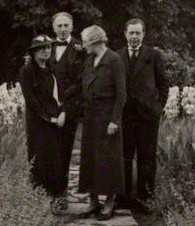Tancred Borenius
| Tancred Borenius | |
|---|---|
|
Borenius (right) photographed by Lady Ottoline Morrell. | |
| Born |
July 14, 1885 Vyborg |
| Died |
September 2, 1948 (aged 63) Salisbury, England |
| Alma mater | University of Helsinki |
| Occupation | Art historian, Diplomat |
| Spouse(s) | Anne-Marie Rüneberg |
| Children | Peter Borenius |
| Parent(s) | Carl Borenius & Olga Borenius |
Carl Tancred Borenius (July 14, 1885, Vyborg – September 2, 1948, Salisbury) was a Finnish art historian working in England, who became the first professor of the history of art at University College London. He was a prolific author and recognised as one of the world's leading experts on Italian art of the early Renaissance.
Borenius also served as a diplomat liaising between Finland and Britain. It has been claimed that during World War II Borenius worked as a spy for the British government and was instrumental in enticing Rudolf Hess to fly to Britain in 1941.
Career
Borenius was the son of Finnish businessman and politician Carl Borenius. He studied at Helsinki and in Italy. He received his Ph.D. from Helsinki University in 1909, after which he moved to London. His first book was a version of his doctoral dissertation, Painters of Vincenza (1909). He married Anne-Marie Rüneberg, a granddaughter of the Finnish poet Johan Ludvig Runeberg.
Borenius soon met Roger Fry, to whom he became close. Fry introduced him to the art circles in Britain, and he became associated with the Bloomsbury group. Borenius was appointed in 1914 as a lecturer at University College London after Fry left. In 1921, he prepared a catalogue of the Northwick Park collection. After Henry Tonks had established the Edwin Durning-Lawrence chair in art history at the university Borenius was appointed its first professor in 1922.[1] In 1933 he became director of the excavations of Clarendon Palace near Salisbury, where he continued to dig regularly until 1939.
Though initially a specialist on Italian art, Borenius became increasingly interested in the art of his adopted country. His opinion on art was highly valued, and he worked as a consultant at Sotheby's. He was also an advisor to the Earl of Harewood's art collection.
He helped to found the art magazine Apollo in 1925, and became one of its most active contributors. He was also actively involved with the Burlington Magazine, of which he became managing editor during World War II from 1940 to 1945.
He wrote numerous books on art, including English Primitives (1924), The Iconography of St. Thomas of Canterbury (1929), Florentine Frescoes (1930), English Painting in the XVIIIth Century (1938) and Rembrandt: Selected Paintings (1942).
Diplomacy
When Finland became independent of Russia, he acted as secretary of the diplomatic mission (1918) and as representative of Finland in London from 1919. In World War II this role became important as Britain initially sought to cultivate links to Finland, which had been attacked by Soviet Russia during the Winter War, as part of the Nazi-Soviet pact. When Germany invaded Russia, Finland became a de facto ally of the Nazis against the Russians. Finnish leader Field Marshal Mannerheim was careful to keep his distance from Hitler and maintain links to the Western Allies.[2] Borenius knew Mannerheim and during the Winter War he wrote a laudatory biography of the general.[3]
Borenius was made Secretary-General of the Polish Relief Fund in 1939, designed to send aid to Poland and assist Polish refugees in Britain. He had long cultivated links between Poland, Finland and Britain, having been vice-president of the Anglo-Polish society before the war. The anti-Nazi journal Free Europe referred to him as "a living symbol of Polish-Finnish collaboration".[4]
Hess claims
The writer John Harris asserts that Borenius was sent by the British to Geneva to deliver a message to an associate of Rudolf Hess as part of a plan to entice him to Britain. The message was an invitation for Hess to meet the British Royal Family to facilitate an Anglo-Nazi alliance, removing Winston Churchill from power. The invitation was a trap. According to Harris, "the incredible plot that led to Hess's capture bought Britain time from a planned German invasion...and ultimately was a turning point in defeating Hitler and winning the war. Without Tancred's involvement, there can be little doubt that Britain, and much of Europe, would be speaking German today."[5][6]
Historian Roger Moorhouse, author of Berlin at War disputed the claims, stating that "MI6 would have little to gain from luring Hess to Britain. Although nominally important, he was actually a peripheral figure by 1941. The most likely theory is that he came over of his own volition."[7]
Notes
- ↑ University College, History of Art department.
- ↑ Vehviläinen, Olli (2002), Finland in the Second World War: Between Germany and Russia, New York: Palgrave.
- ↑ J. E. O. Screen, Mannerheim: the years of preparation, C. Hurst & Co, 2001, p.4-5.
- ↑ Free Europe: Central and East European Affairs, Volume 1, 1939, p.48.
- ↑ Metro, 25 October, 2010
- ↑ Daily Mail
- ↑ "Rudolf Hess 'was lured to Britain by MI6 plot", Daily Telegraph, 26th Oct, 2010.
